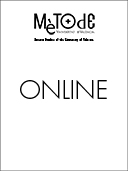A vindication of ethnobotany: Between social and natural science
DOI:
https://doi.org/10.7203/metode.6.4402Palabras clave:
ethnobiology, ethnobotany, citizen science, natural science, social science, multidisciplinarity Resumen
Resumen
Ethnobotany, a discipline located at the intersection between natural science and social science, is sometimes misunderstood by researchers from one field or the other. In this article we will discuss the positive and negative aspects of interdisciplinarity regarding this subject, and we will argue its status as science from different points of view. Our conclusion is that ethnobotanical inquiry – as any other ethnobiological inquiry – falls within the scientific field and is currently fairly consolidated, active and productive. In addition, ethnobotany is a citizen science: the participation of the population is essential for research, which must be communicated to the academia, but also to the common citizen
 Descargas
Descargas
 Citas
Citas
Barrau, J. (1971). L’ethnobotanique au carrefour des sciences naturelles et des sciences humaines. Bulletin de la Société Botanique de France, 118, 237–248. doi: 10.1080/00378941.1971.10838893
Bennett, B. C. (2005). Ethnobotany education, opportunities and needs in the U.S. Ethnobotany Research & Applications, 3, 113–121.
Berlin, B. (1992). Ethnobiological classification: Principles of categorization of plants and animals in traditional societies. Princeton: Princeton University Press.
Bonney, R., Cooper, C. B., Dickinson, J., Kelling, S., Phillips, T., Rosenberg, K. V., & Shirk, J. (2009). Citizen science: A developing tool for expanding science knowledge and scientific literacy. BioScience, 59, 977–984. doi: 10.1525/bio.2009.59.11.9
Camarasa, J. M. (1984). Pius Font i Quer: Un precursor de l’etnobotànica farmacèutica a Catalunya. Arxiu d’Etnografia de Catalunya, 3, 175–186.
Font i Quer, P. (1916). La ciència d’en Sovatger. Butlletí del Centre Excursionista de la Comarca del Bages, 66, 142–145.
Hand, E. (2010). Citizen science: People power. Nature, 466, 685–687. doi: 10.1038/466685a
Harshberger, J. W. (1896). Purposes of ethnobotany. Botanical Gazette, 21, 146–154.
Heinrich, M. (2000). Ethnobotany and its role in drug development. Phyto-therapy Research, 14, 479–488. doi: 10.1002/1099-1573(200011)14:7<479::aid-ptr958>3.0.co;2-2
Irwin, A. (1995). Citizen science: A study of people, expertise and sustainable development. London: Routledge.
Lévi-Strauss, C. (1962). La pensée sauvage. Paris: Plon. Palacín, J. M. (1994). La “medicina popular”: Fuentes para su estudio y método de trabajo. Metodología de la Investigación Científica Sobre Fuentes Aragonesas, 9, 359–419.
Pardo de Santayana, M. (2014). Etnobotánica e inventario español de conocimientos tradicionales. Conservación Vegetal, 18, 1–4.
Pardo de Santayana, M., Pieroni, A., & Puri, R. (Eds.) (2010). Ethnobotany in the new Europe. People, health and wild plant resources. New York-Oxford: Berghahn Books.
Portères, R. (1970). Cours d’ethno-botanique et ethno-zoologie (1969-1970). Volume I. Paris: Muséum National d’Histoire Naturelle.
Saslis-Lagoudakis, C. H., Klitgaard, B. B., Forest, F., Francis, L., Savolainen, V., Williamson, E. M., & Hawkins, J. A. (2011). The use of phylogeny to interpret cross-cultural patterns in plant use and guide medicinal plant discovery: An example from Pterocarpus (Leguminosae). PLoS ONE, 6(7), e22275. doi: 10.1371/journal.pone.0022275
Schultes, R. E., & von Reis, S. (Eds.). (1995). Ethnobotany: Evolution of a discipline. London: Chapman and Hall.
Snow, C. P. (1965). Les dues cultures i la revolució científica. Barcelona: Edicions 62.
Trotter, R. T., & Logan, M. H. (1986). Informant consensus: A new approach for identifying potentially effective medicinal plants. In N. L. Etkin (Ed.), Plants in indigenous medicine and diet, behavioural approaches. New York: Redgrave Publishing Company.
Descargas
Publicado
Cómo citar
-
Resumen1689
-
PDF 464
Número
Sección
Licencia
![]()
Todos los documentos incluidos en OJS son de acceso libre y propiedad de sus autores.
Los autores que publican en esta revista están de acuerdo con los siguientes términos:
- Los autores conservan los derechos de autor y garantizan a Metode Science Studies Journal el derecho a la primera publicación del trabajo, licenciado bajo una licencia de Creative Commons Reconocimiento-NoComercial-SinObraDerivada 4.0 Internacional, que permite a otros compartir el trabajo con un reconocimiento de la autoría del trabajo y citando la publicación inicial en esta revista.
- Se permite y se anima a los autores a difundir sus trabajos electrónicamente a través de páginas personales e institucionales (repositorios institucionales, páginas web personales o perfiles a redes profesionales o académicas) una vez publicado el trabajo.





